Are you gearing up for a visit to Marrakech? Fantastic choice! This city is a treasure trove of experiences, standing out as one of the most remarkable cities globally. Marrakech, often referred to as Morocco’s jewel, boasts a rich tapestry of history and culture that spans centuries.
Strolling through the streets of Marrakech today transports you into an extraordinary realm filled with distinct visuals, enchanting sounds, aromatic scents, and delightful flavors.
In this post, you’ll find all the essentials to make your trip to Marrakech unforgettable.
Why visit Marrakech In 2024?
Known as “the Red City” for its ancient 12th-century walls that encircle the Old Medina, Marrakech dazzles visitors with its deep-rooted history and vibrant present.
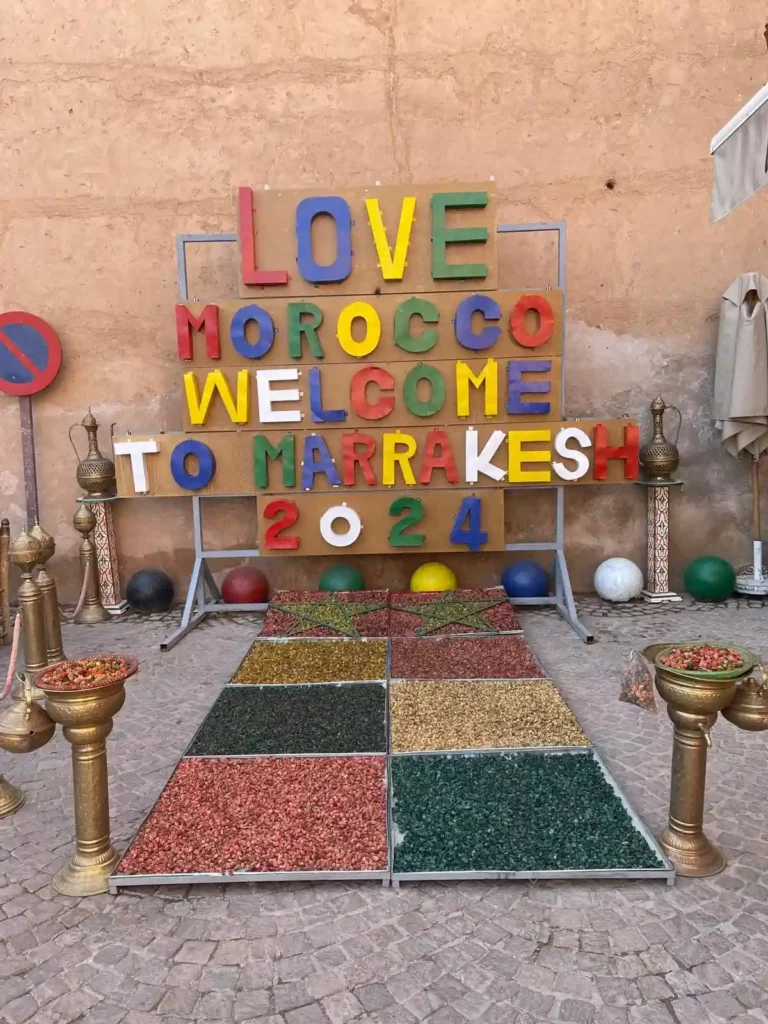
The heart of Marrakech beats in Jemma El Fena, Africa’s most animated square. Here, surrounded by the largest traditional market in Morocco, you can dive into a sensory feast of sights, sounds, and smells, enjoying unparalleled shopping and entertainment.
Just a short walk away, the imposing Koutoubia Mosque stands as a testament to the city’s architectural grandeur, while the nearby tanneries offer a peek into the art of traditional Moroccan craftsmanship.
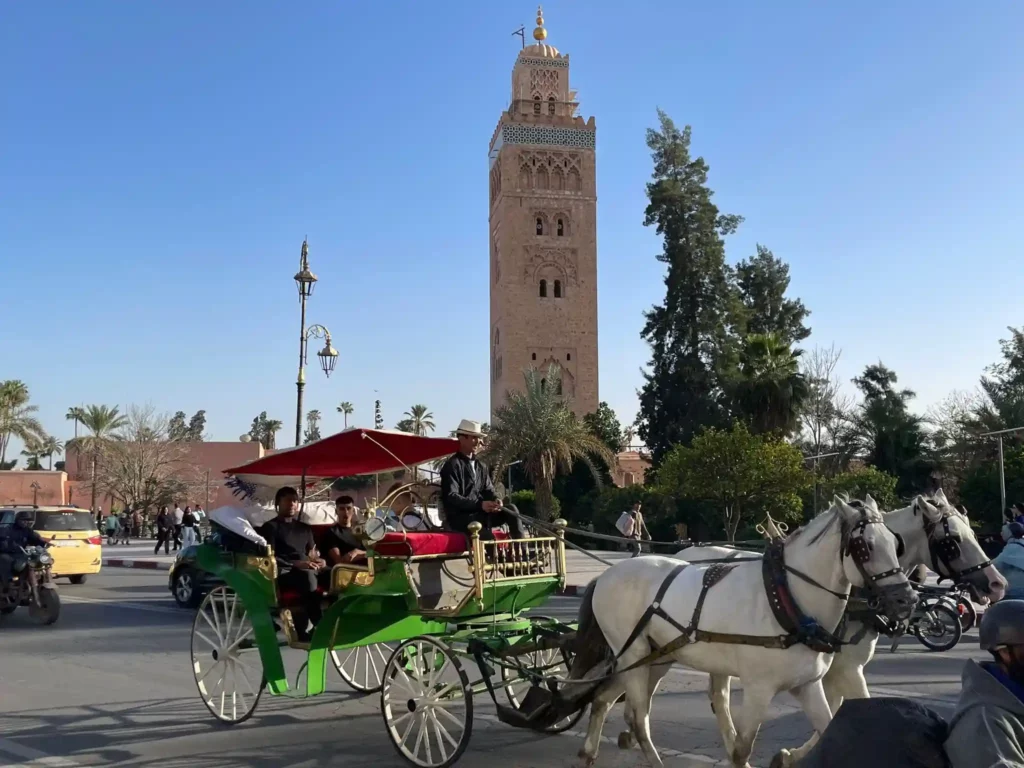
But Marrakech isn’t just a feast for the senses—it’s a city that plays a pivotal role in Morocco’s economy and stands as a beacon for travelers seeking adventure and inspiration.
This guide promises to unveil the many layers of Marrakech, making it a must-visit destination for those seeking adventure and cultural immersion.
Top Things to Do in Marrakech
1. Check Bab Agnaou (Agnaou Gate)
Bab Agnaou is one of Marrakech’s most famous historical landmarks, serving as one of the main gates into the old city, or Medina, of Marrakech.
It was constructed in the 12th century during the Almohad dynasty’s reign.
Unlike many other city gates, which were primarily defensive, Bab Agnaou also served a ceremonial purpose, providing a grand entrance to the royal kasbah (fortress) located within the city walls.
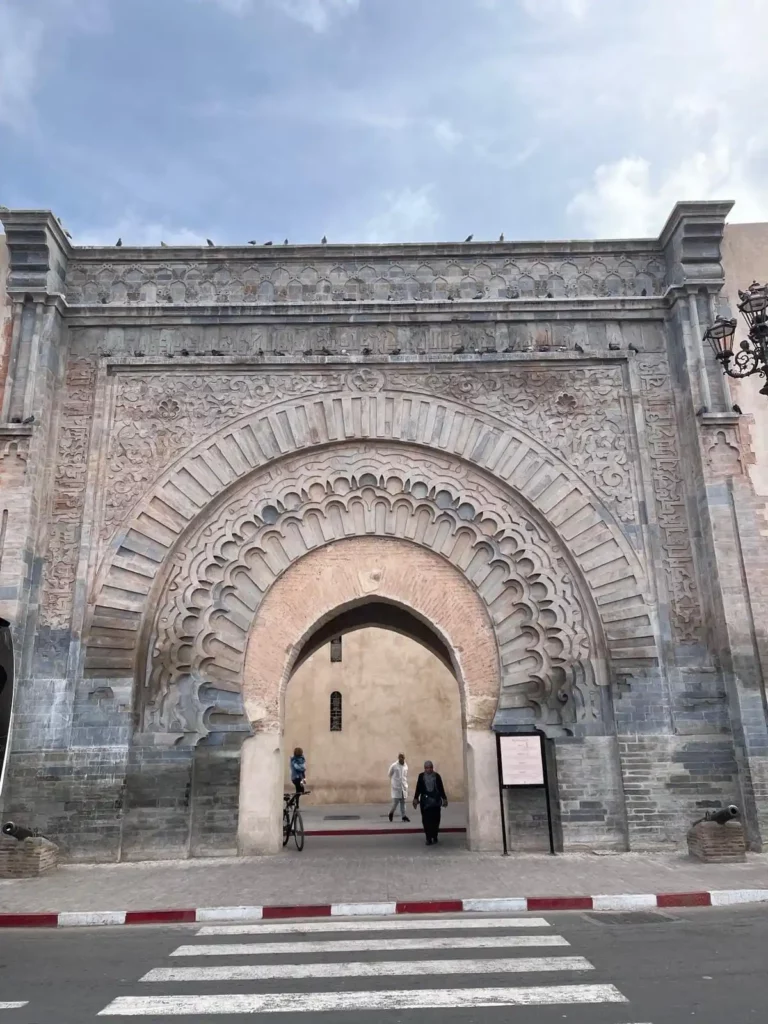
The gate was built using local stone and what struck me most was the exquisite detail carved into its stone facade.
You will notice floral patterns, Arabic calligraphy, and a horseshoe arch that frames the gateway. All these features represent a blend of our Moroccan and Islamic art that defines much of the city’s architecture.
2. Marvel at Al Koutoubia Mosque
Our next highlight in Marrakech is the majestic Koutoubia Mosque. It’s Marrakech’s largest and tallest spiritual haven, standing proudly in the Medina.
With its towering minaret reaching 253 feet (77m) into the sky, it’s a landmark that’s visible from miles around.
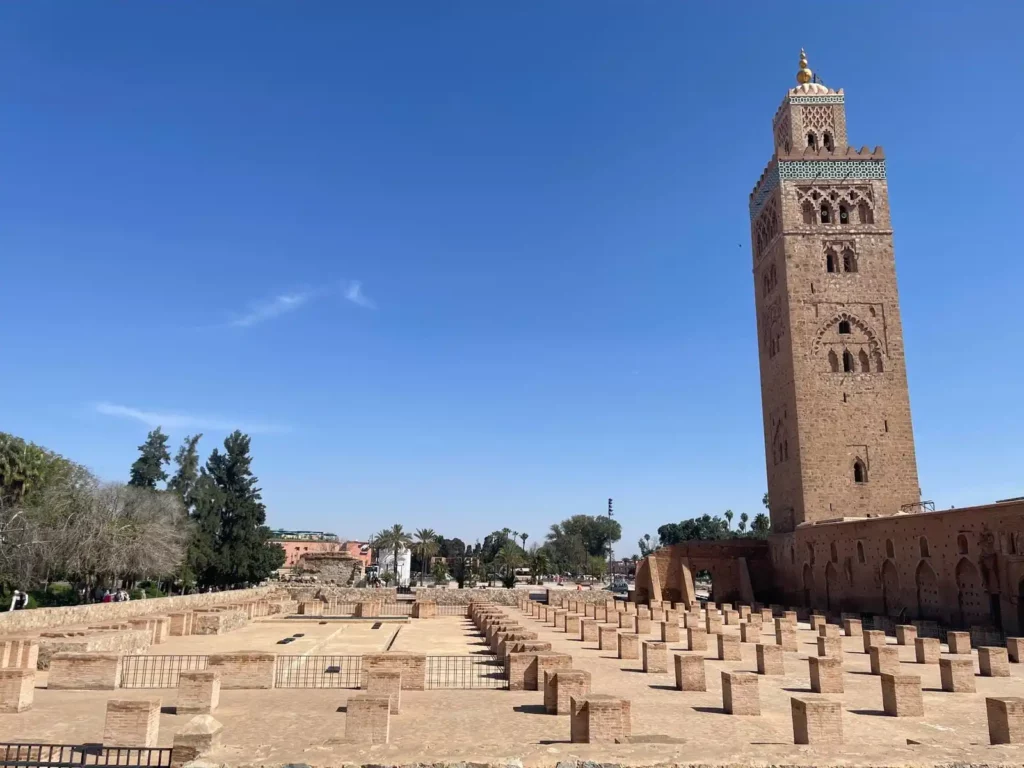
Constructed in the 12th century, Al Koutoubia has served as a source of inspiration for many of Morocco’s significant buildings, including the grand Hassan II Mosque in Casablanca.
While Al Koutoubia remains an active mosque, hosting Muslim prayers five times daily, its interiors are reserved for worshippers.
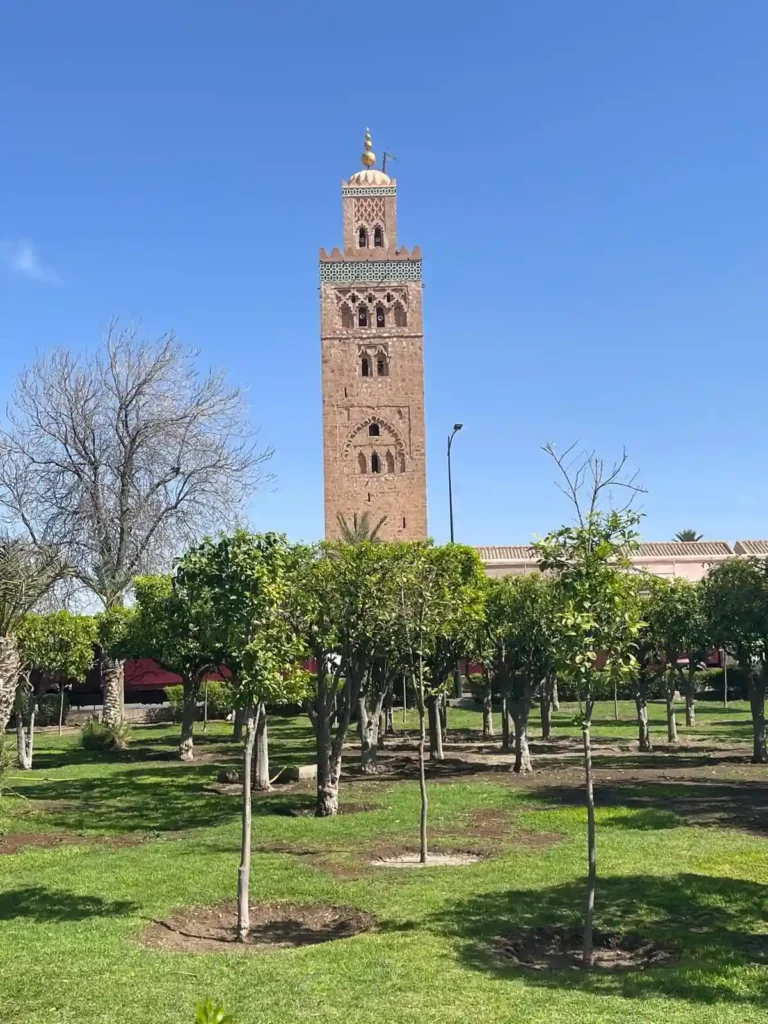
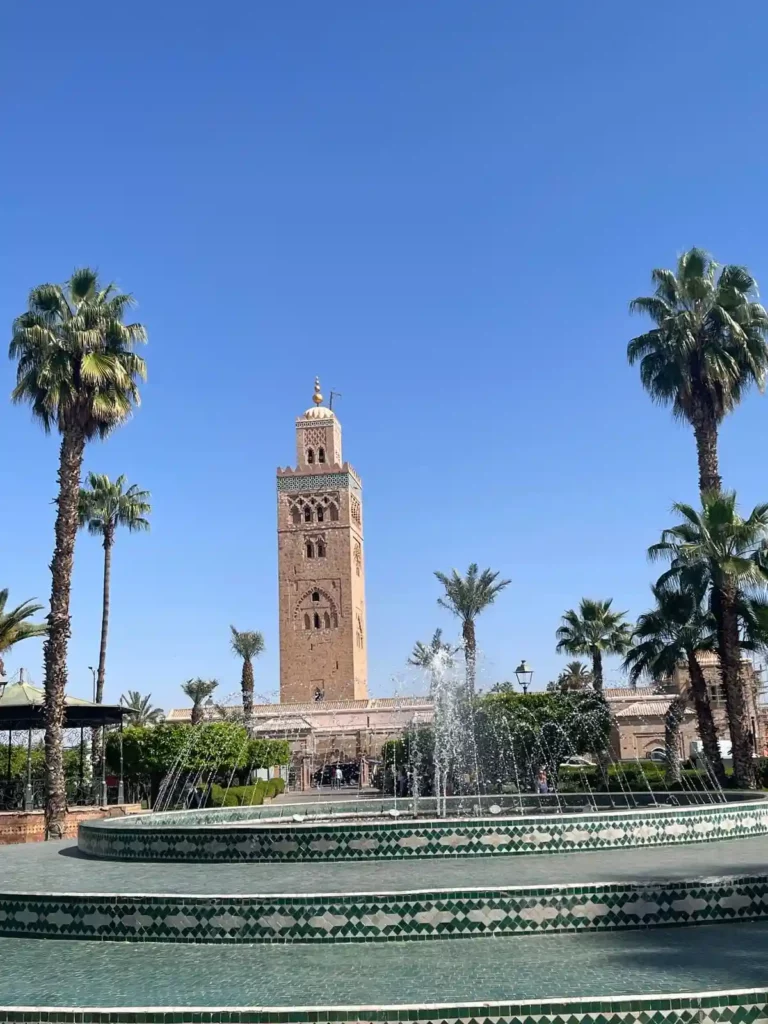
However, visitors are warmly encouraged to explore the serene gardens that envelop this historical gem.
Walking around, you can feel the pulse of history and spirituality that makes Al Koutoubia a must-visit on any Marrakech itinerary.
3. Visit The Museum of Marrakech
There’s one spot in the old center of this vibrant city that you absolutely cannot miss: The Museum of Marrakech, also known as Musee de Marrakech.
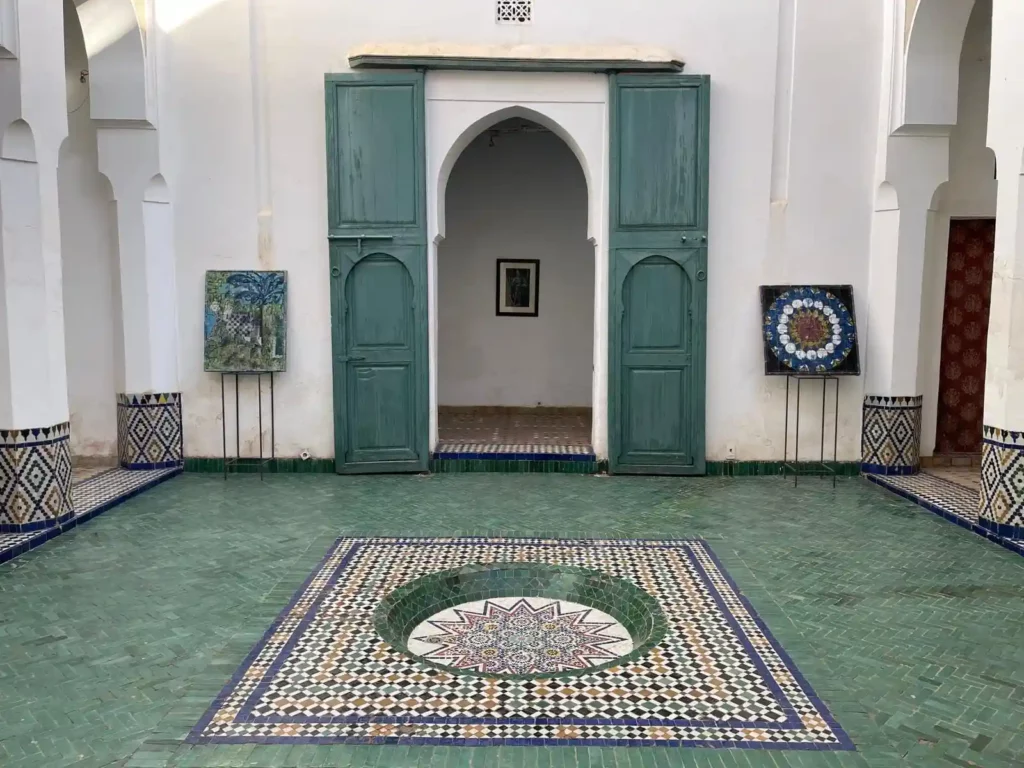
the Museum of Marrakech, originally the Dar Mnebhi Palace, is a captivating blend of history and art.
Walking into the museum, you’re immediately transported into a world of architectural beauty.
The palace showcases the exquisite Moroccan architecture of the late 19th and early 20th centuries.
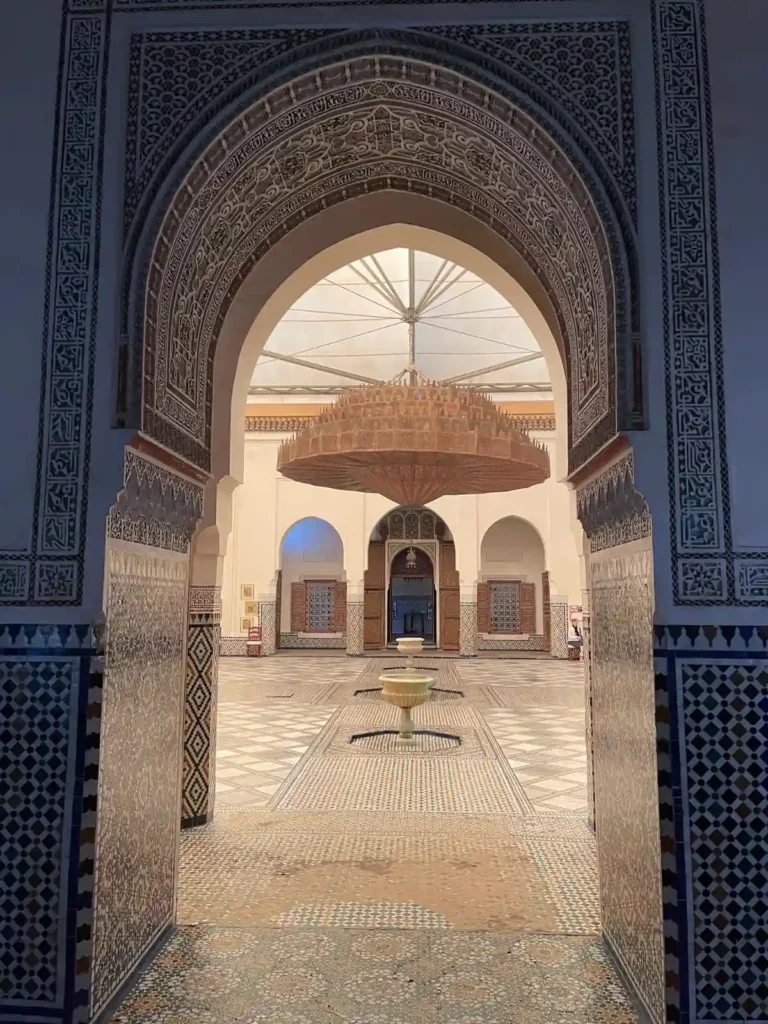
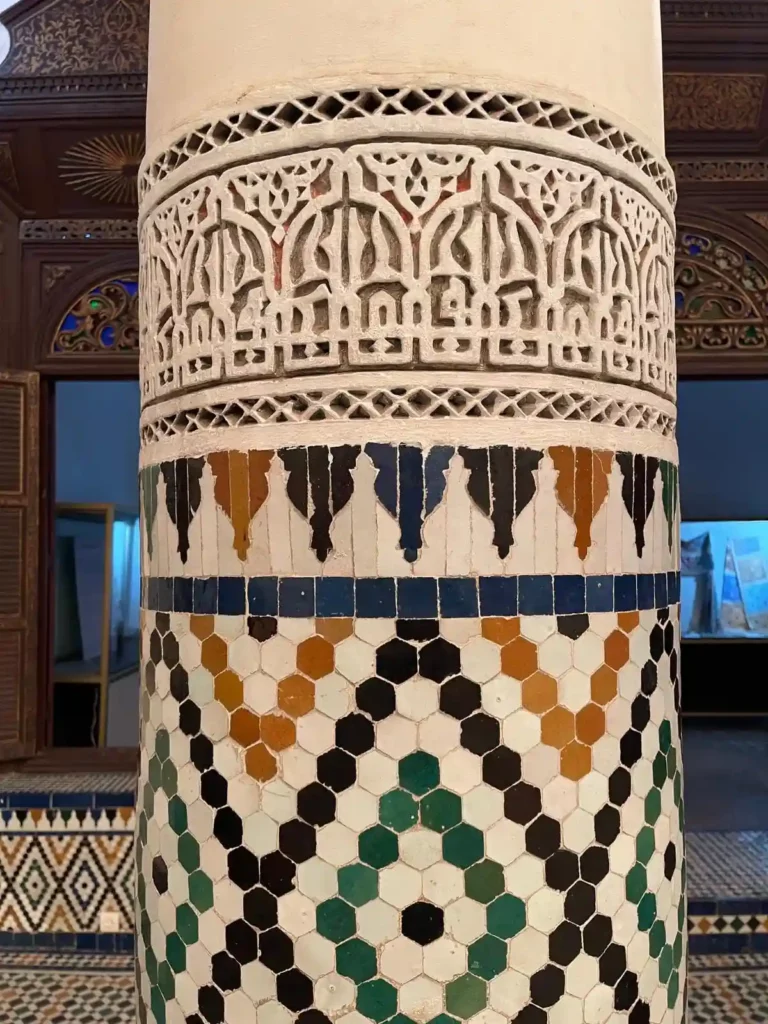
The heart of the palace is its large central courtyard, a grand, paved area illuminated by a spectacular central chandelier.
As you meander through the museum, you’ll find yourself surrounded by colorful zellij tilework, painted and carved cedar wood, historic art objects and contemporary Moroccan art.
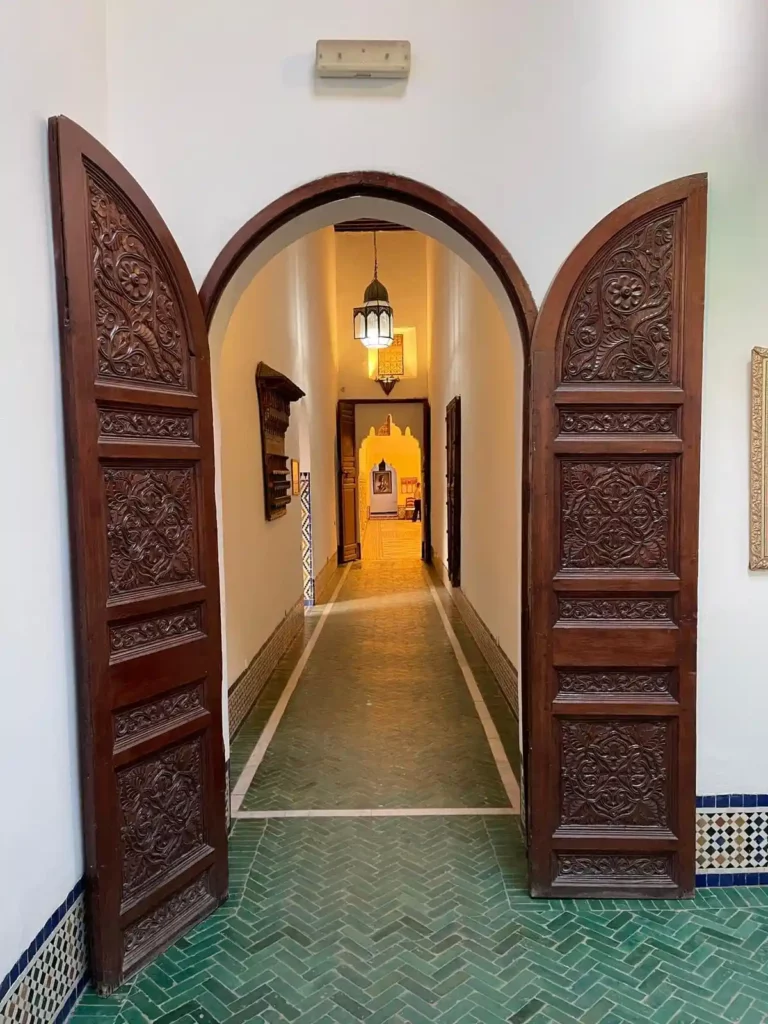
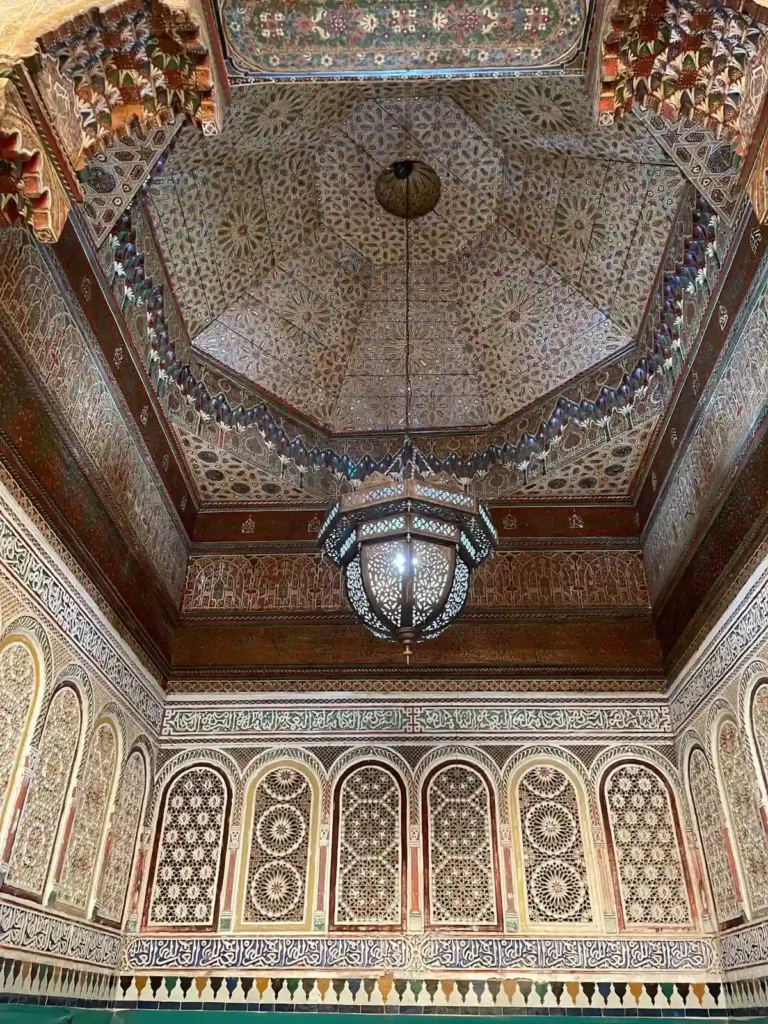
The once-private chambers, now open for all to see, are adorned with intricate wood and stucco work, each telling its own part of Moroccan history.
4. Wander at Jama El Fena square
Next, head over to the expansive Jemaa El Fna square, renowned for its lively and extraordinary performances and entertainment options.
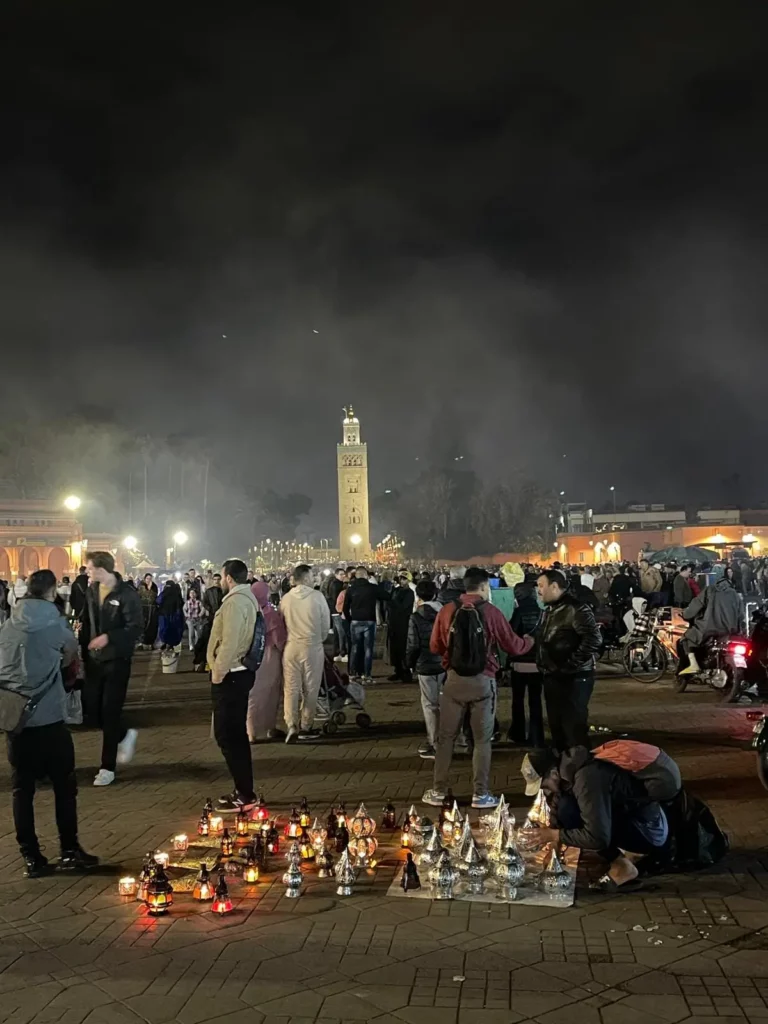
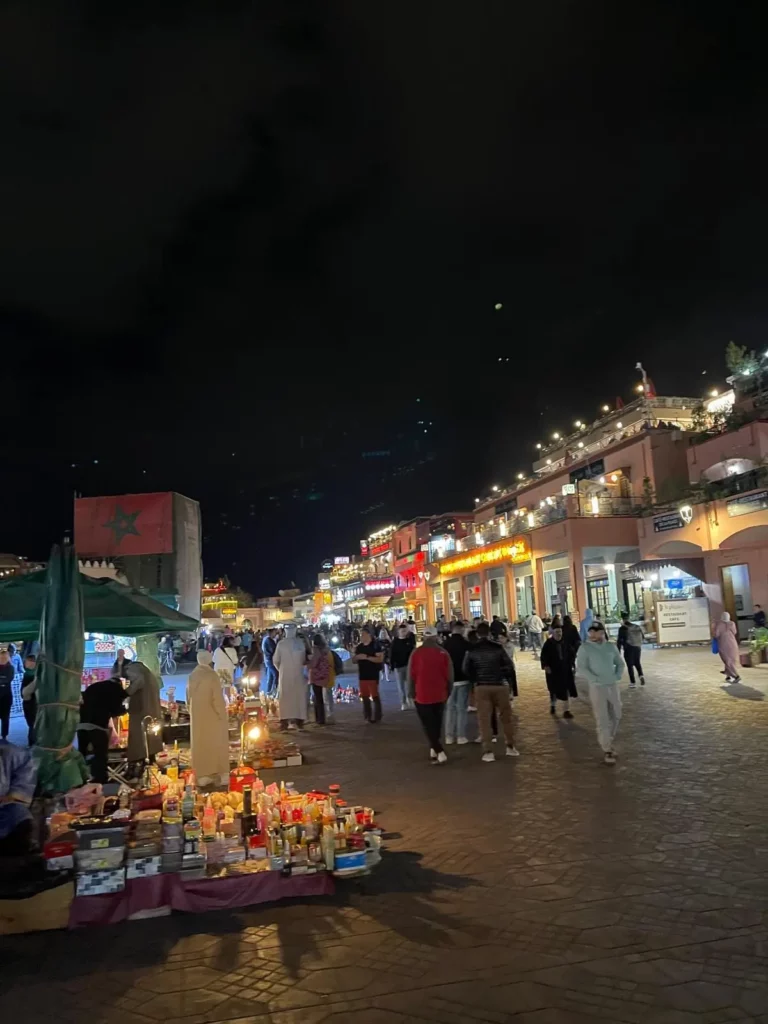
This square is a highlight of any visit to Marrakech. Best is to experience Jemaa El Fena in the evening and immerse yourself in a mesmerizing cultural spectacle of Moroccan music and songs.
What starts as a bustling marketplace for trade and commerce during the day undergoes a remarkable transformation at night.
At night, Jemaa El Fna becomes a sprawling outdoor eatery, a live concert venue, and a vibrant gathering place where people enjoy, sing, and savor delicious Moroccan street food.
5. Go Back in Time at El Bahia Palace
La Bahia Palace, or “The Beautiful,” is one of the most stunning places to see in Marrakesh. The palace’s history dates back to the 1860s, built by Grand Vizier Si Moussa, and later expanded by his son, Abu Ahmed, from 1894 to 1900.
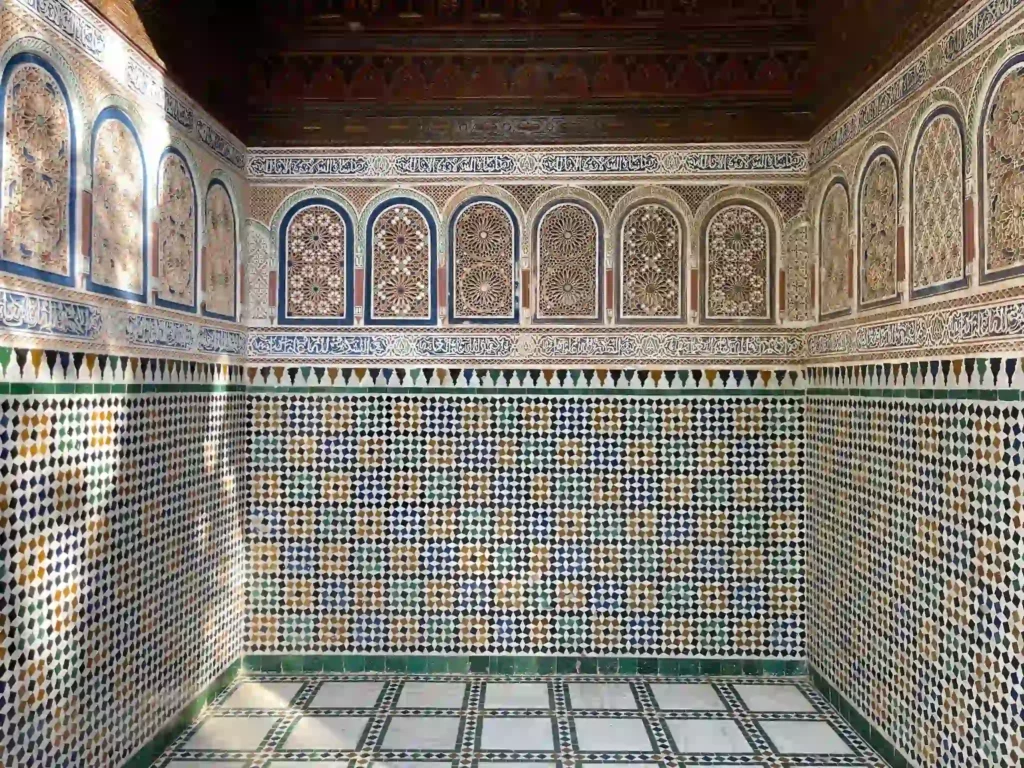
Spread over eight hectares, the palace opens many of its 150 rooms to the public, and its large areas are often used for significant cultural events.
Bahia Palace is a marvel of opulence, featuring floor-to-ceiling decorations like intricate marquetry, plasterwork, and zouak (painted wood).
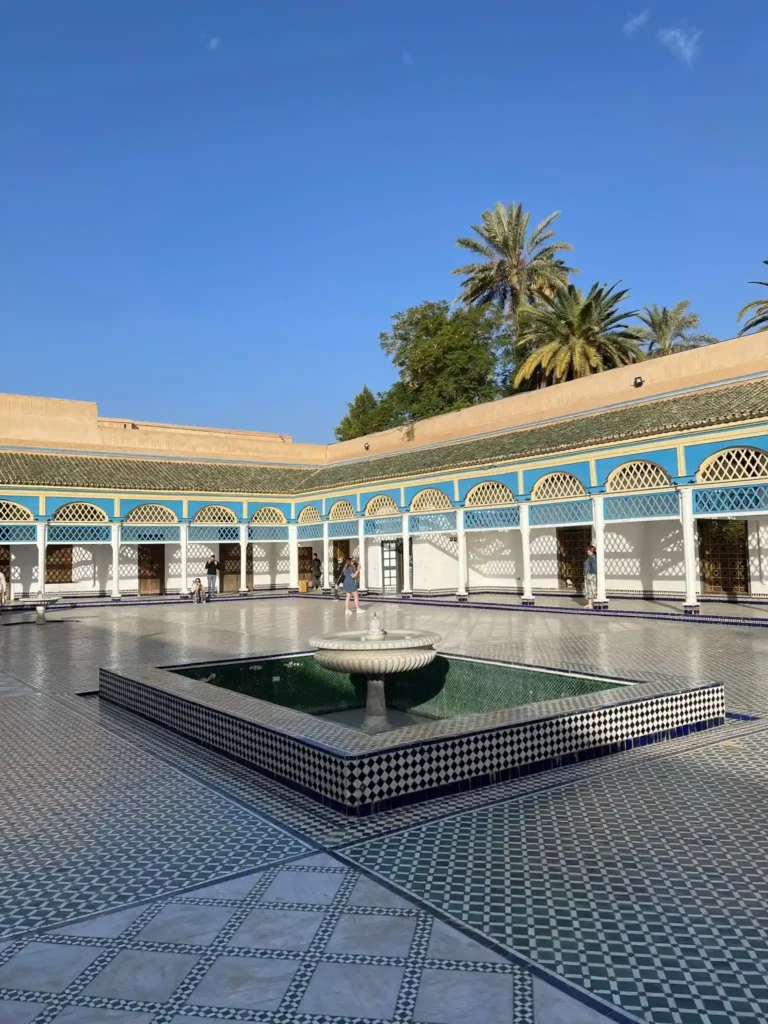
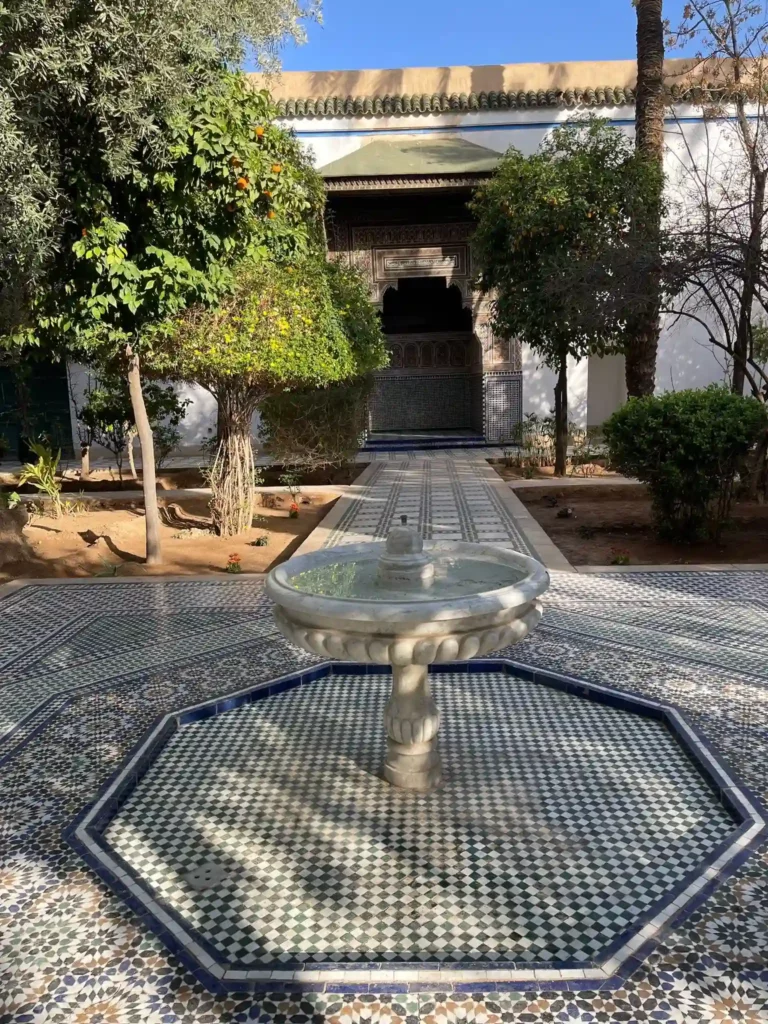
The palace’s Petit Riad and Grand Riad are known for their detailed woodwork and ceilings, but the Cour d’Honneur (grand courtyard) steals the show.
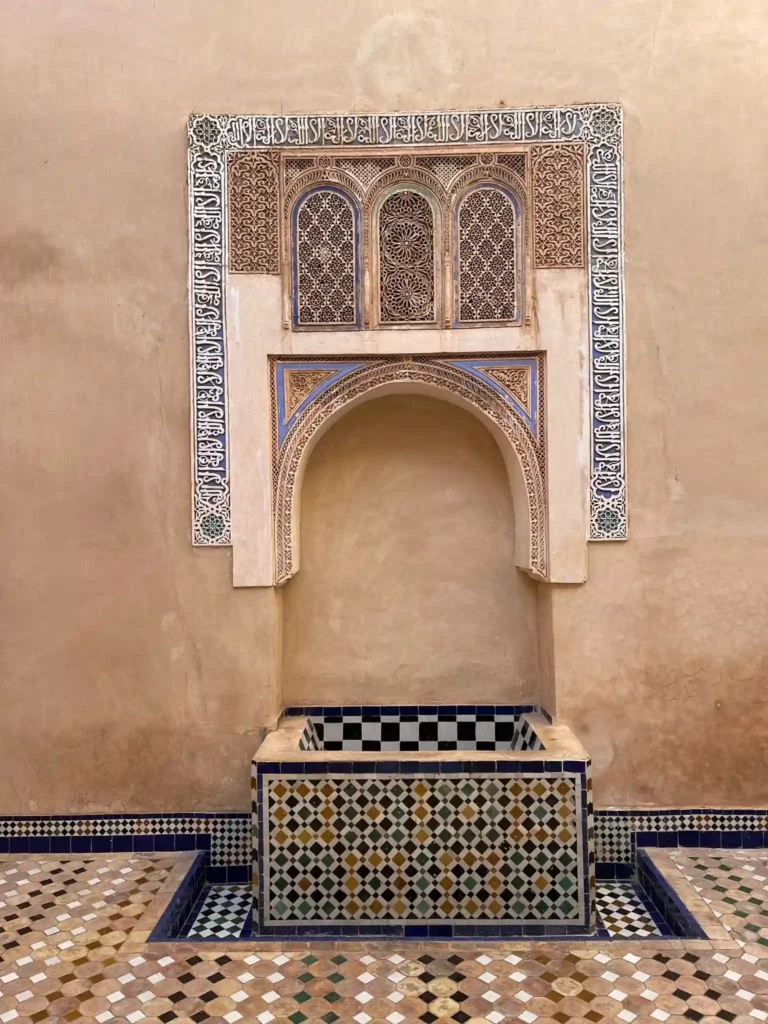
This grand courtyard boasts a floor made of Italian Carrara marble, covering 1,500 square meters, making it the palace’s most celebrated feature.
6. Visit the Saadian Tombs
The Saadian Tombs are a significant part of the city’s history, dating back to the Saadian dynasty, especially the time of Ahmad al-Mansur (1578–1603).
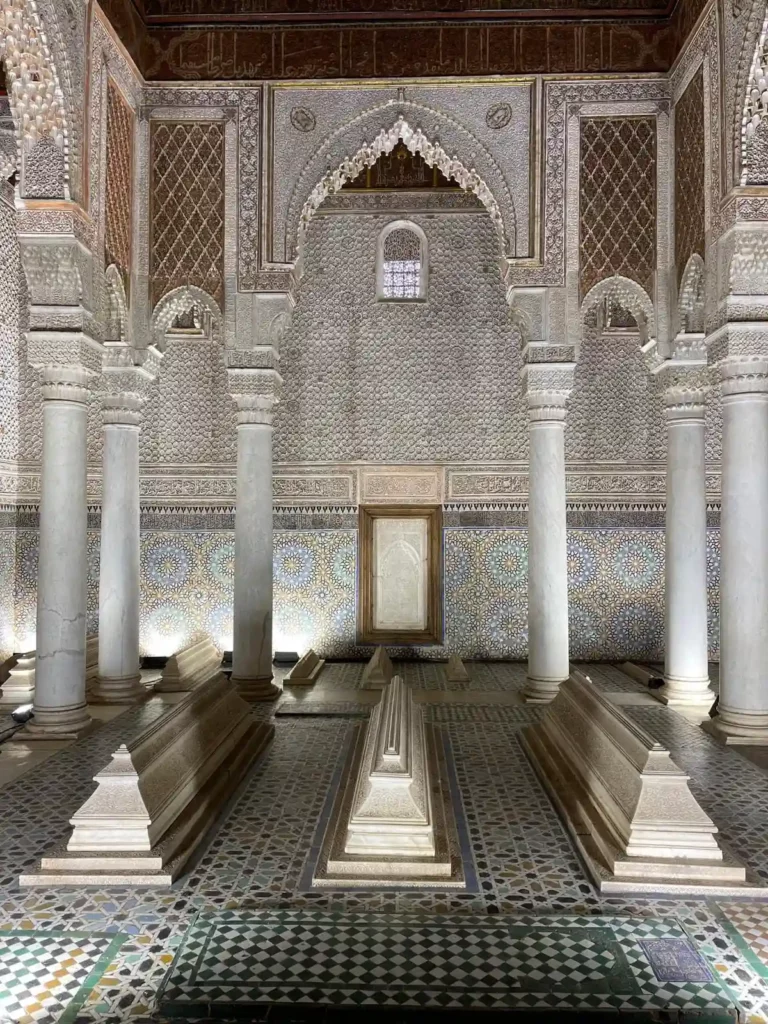
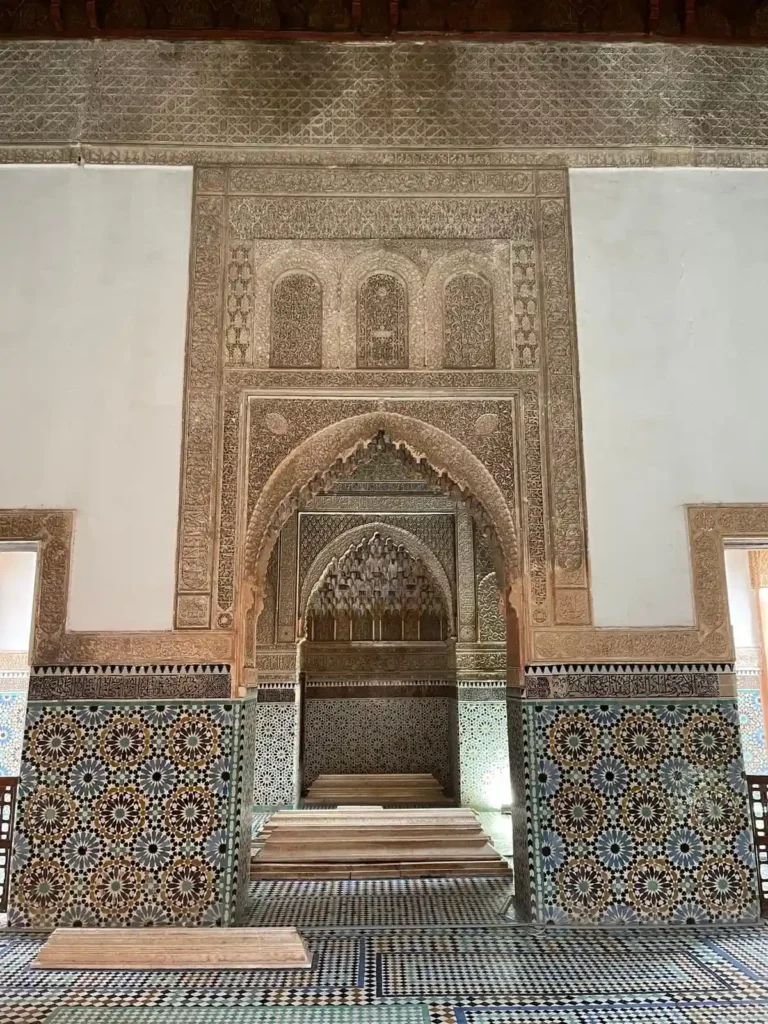
Inside, there are 66 graves of princes and other important figures, plus over 100 others like advisors and their wives. The closer a tomb is to the Sultan’s grave, the more important the person was.
Art historians admire this place for its beautiful design and decorations from that period.
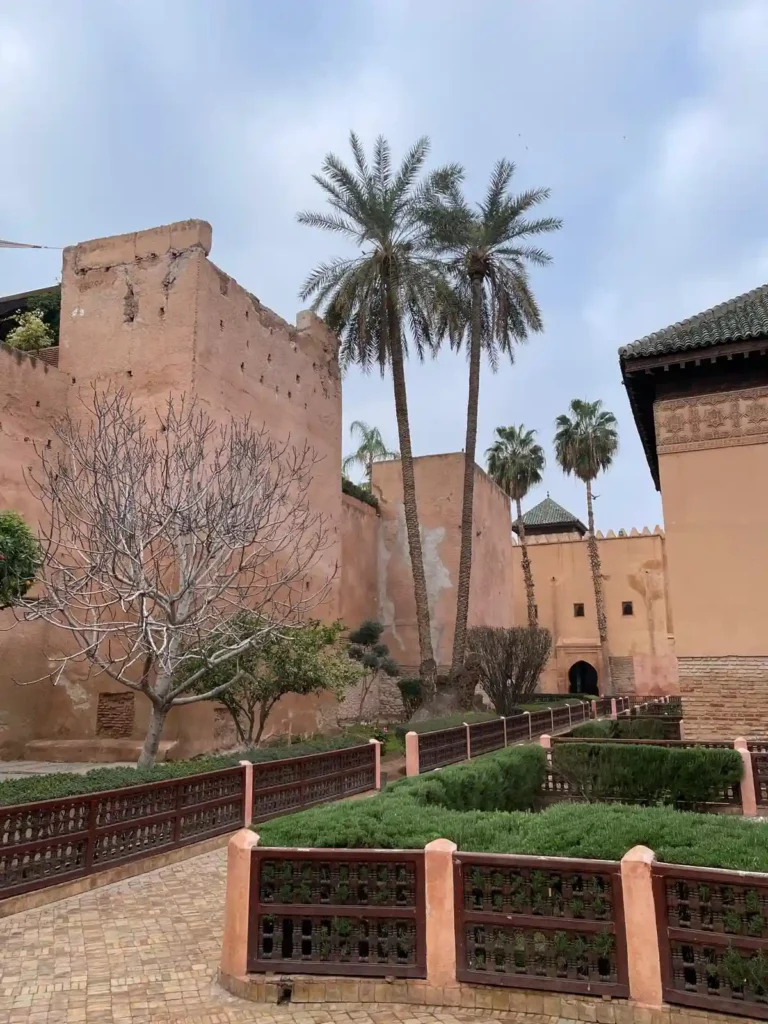
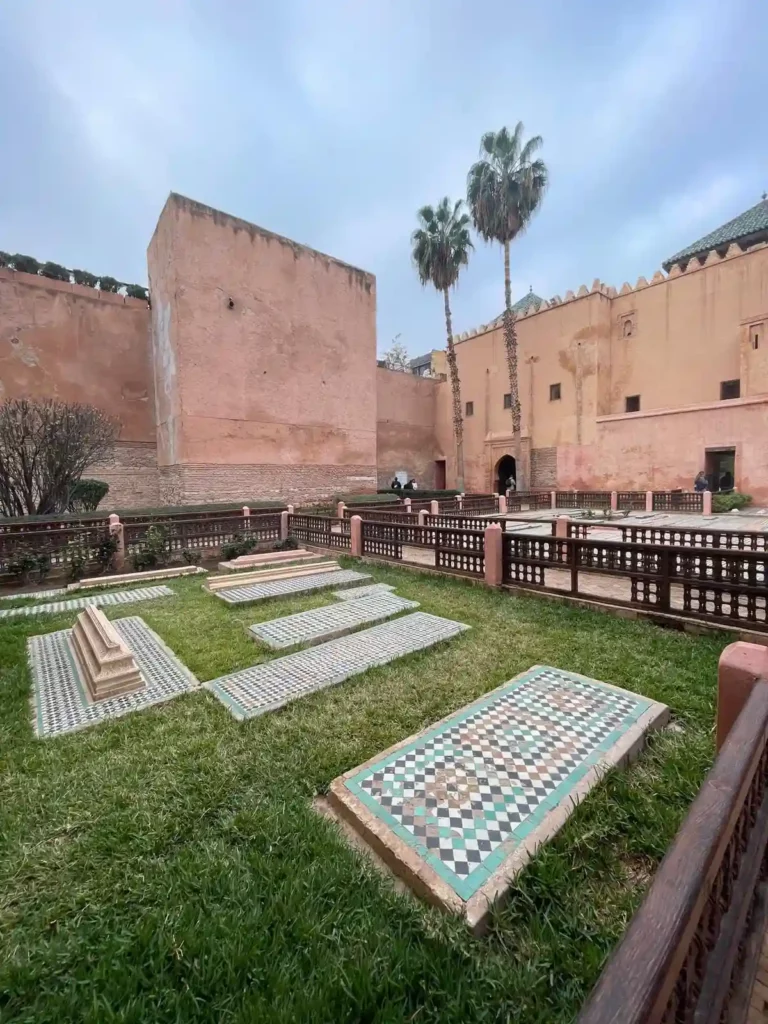
The tombs showcases stunning use of marble, intricate mosaic tile work known as zellij, and finely carved cedar wood.
Also, the care put into the geometric patterns and Arabic calligraphy at the Saadian Tombs really caught my attention. It makes you think about how much effort and skill went into creating such beautiful art back then.
7. Marvel at Marrakech Gardens
The Majorelle Garden offers a tranquil oasis tucked away in the bustling city of Marrakech.
It was created by the French painter Jacques Majorelle over forty years, beginning in the 1920s.
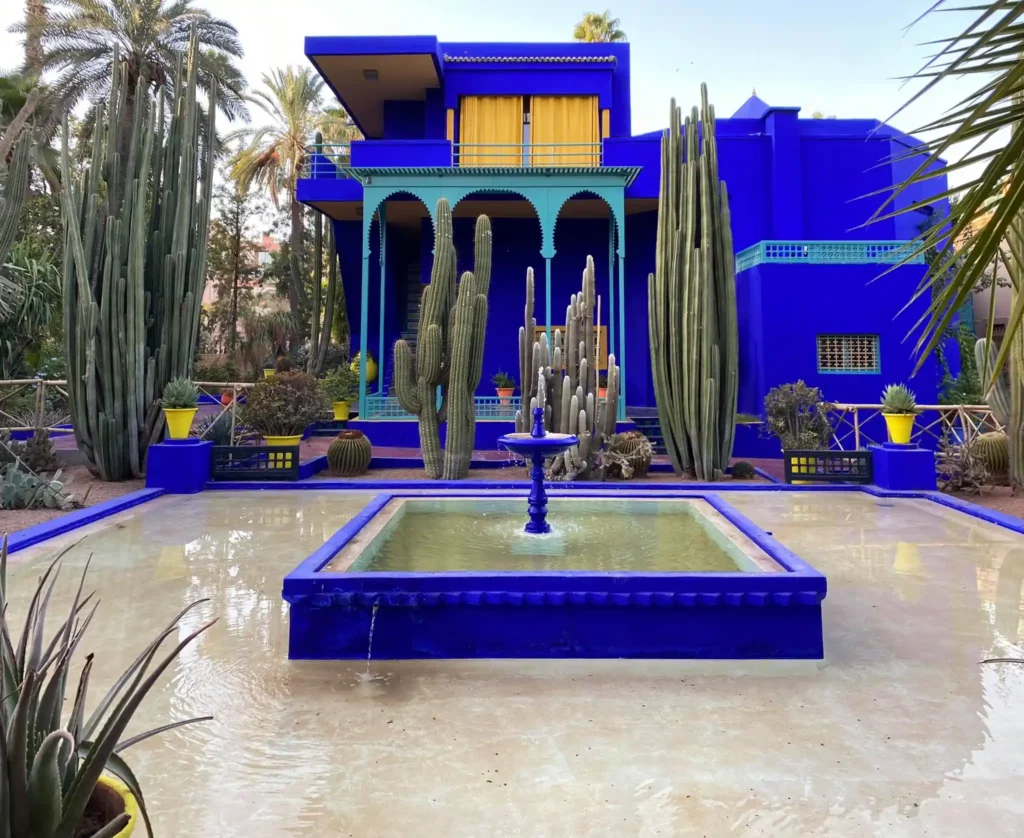
This garden is a masterpiece of botanical beauty and landscape design, painted with vibrant shades of blue (known also as Majorelle Blue) that adorn the villa and other garden structures.
Stepping into the Majorelle Garden, we were transported into a world of lush greenery, exotic plants from across the globe, and the soothing sounds of running water from its fountains and streams.
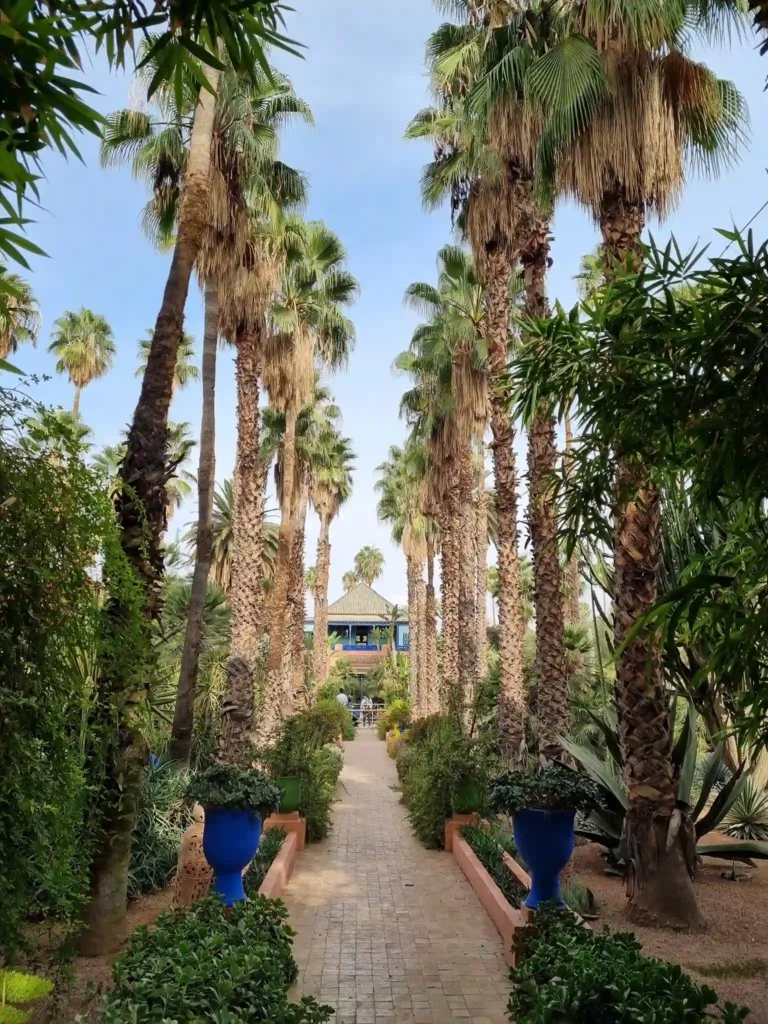
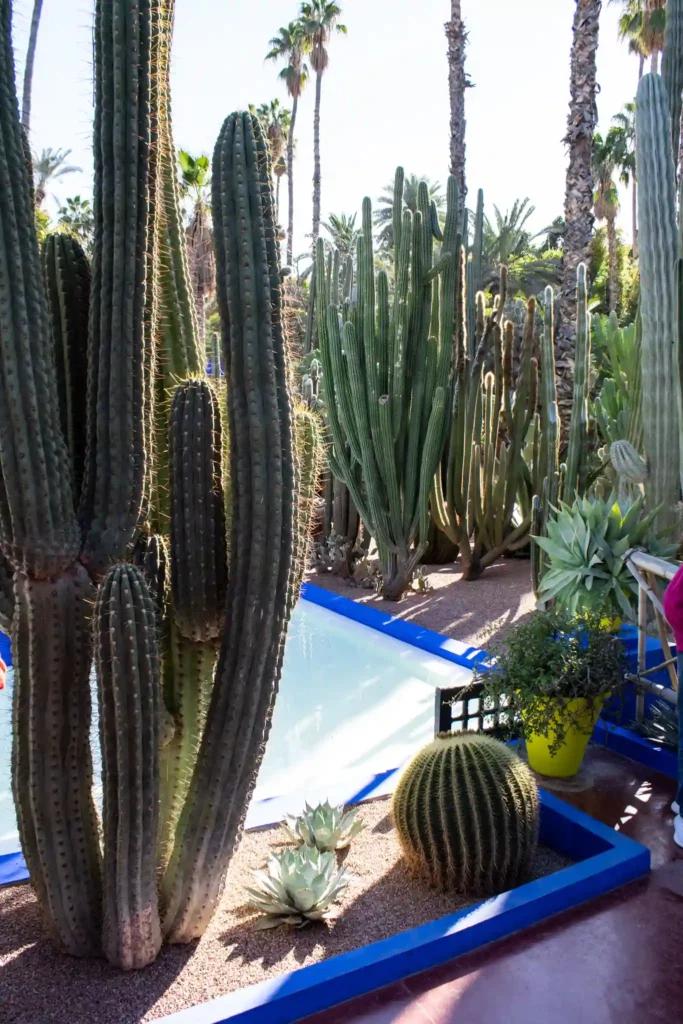
The garden is home to more than 300 plant species, ranging from palms and bamboo to cacti and ferns, creating a spectacular display of diversity and color.
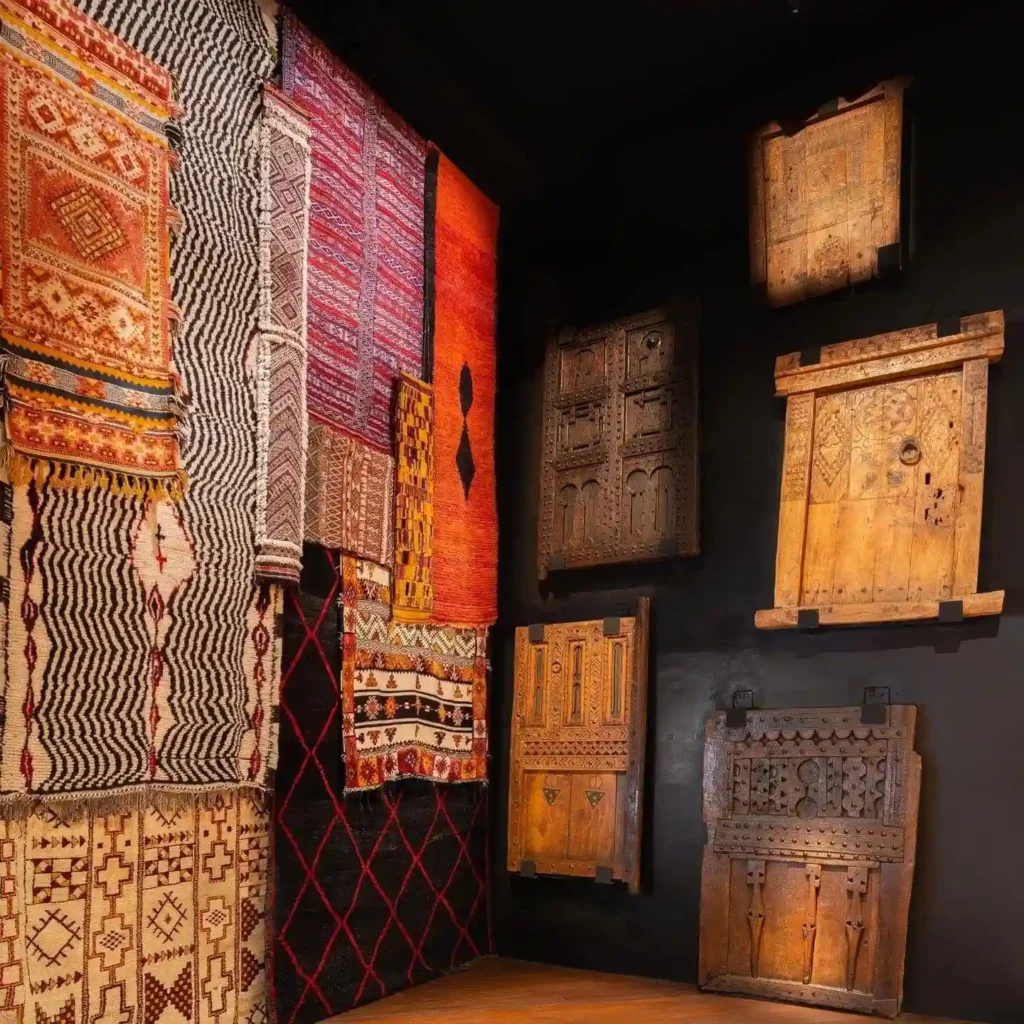
The garden also houses the Islamic Art Museum of Marrakech, the Yves Saint Laurent Museum, and a Berber Museum, making it not only a place of natural beauty but also a cultural hub.
8. Go On a Food Tour
When you find yourself wandering the vibrant streets of Marrakech, indulging in a food tour should be at the top of your to-do list.
There’s no better way to immerse yourself in the rich tapestry of Moroccan culture and cuisine than by exploring its flavors firsthand.
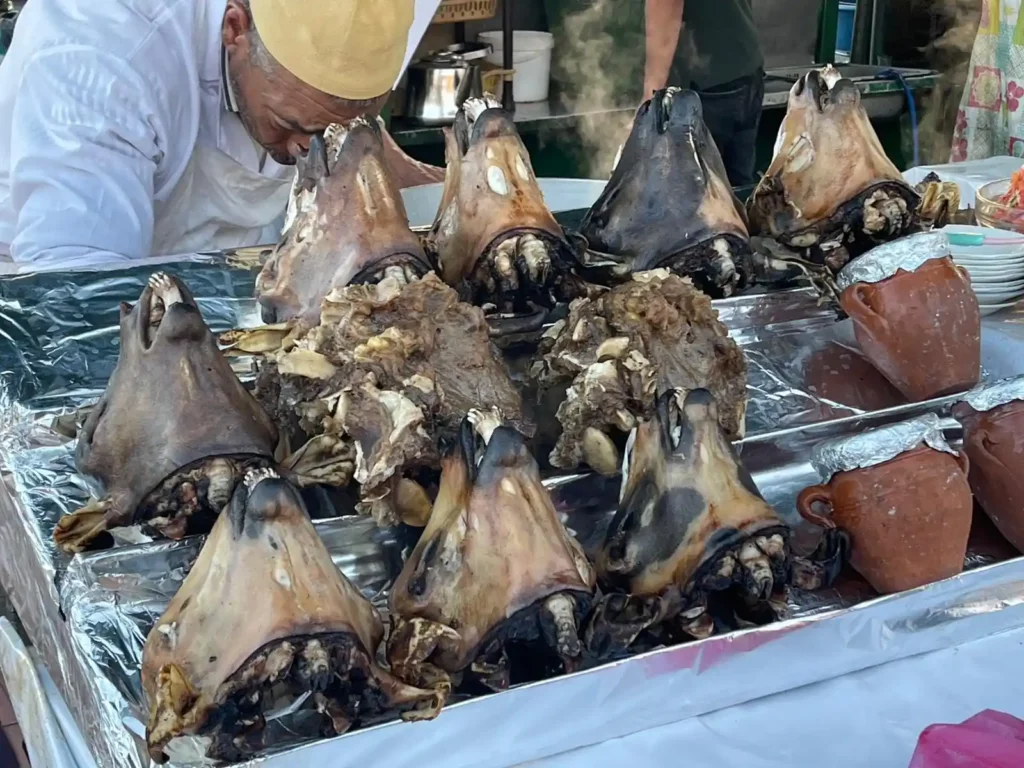
Marrakech is renowned for its culinary scene, a paradise for those eager to explore and taste delicious Moroccan dishes. The heart of this gastronomic adventure often beats in the Medina, where you’ll join a cozy group of fellow food enthusiasts.
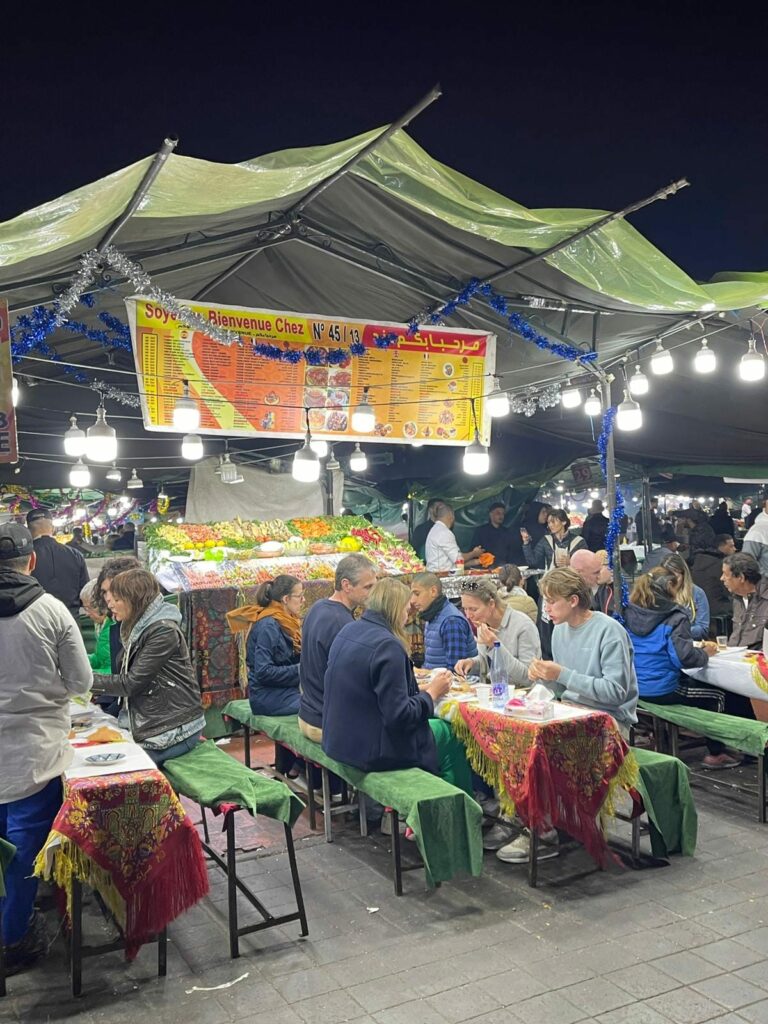
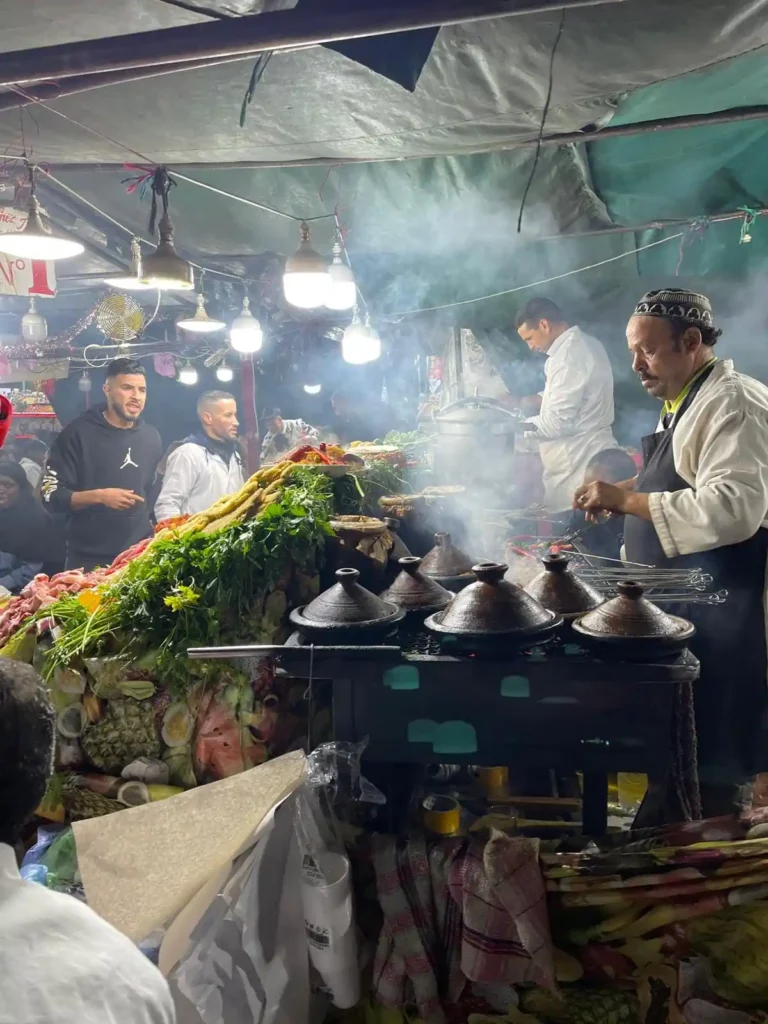
The journey is an adventure in itself, featuring a series of tasting stops tucked away in the Medina’s alleys and backstreets. These are the places beloved by locals, offering authentic experiences far removed from the typical tourist trails.
W’ve personally savored these moments in Marrakech, not only for the food but also for my husband to experience the local life.
A word to the wise: come hungry. The variety and volume of food you’ll encounter are staggering.
9. Enjoy a Hammam Experience
Hammam rituals are a special part of life here in Morocco. Most of us locals make it a point to visit a traditional Hammam once a week for about two hours of relaxation and pampering.
A Hammam is like a steamy bathhouse with a few rooms, each one warmer than the last, so you can pick the temperature you like best.
When you’re in a Hammam, you get to use special Moroccan beauty products on your skin and scrub away dead skin with a special cloth called a Kessa.
You can find Hammams that are open to everyone at a cheap price (around $1) or private ones that are usually in hotels and are a bit fancier.
If you want to try it, it’s a good idea to book a Hammam visit through your hotel or Riad. This way, you’re all set for a relaxing experience that’s a big part of Moroccan culture.
Hammam sessions can be also booked in advance. Check a few options here.
Read more: What to Expect During A Moroccan Hammam
10. Visit Marrakech’s new town “Gueliz”
While newcomers might prioritize the city’s iconic cultural heritage, those returning can explore its contemporary facet, or the “new city of Marrakech,” for a novel view.
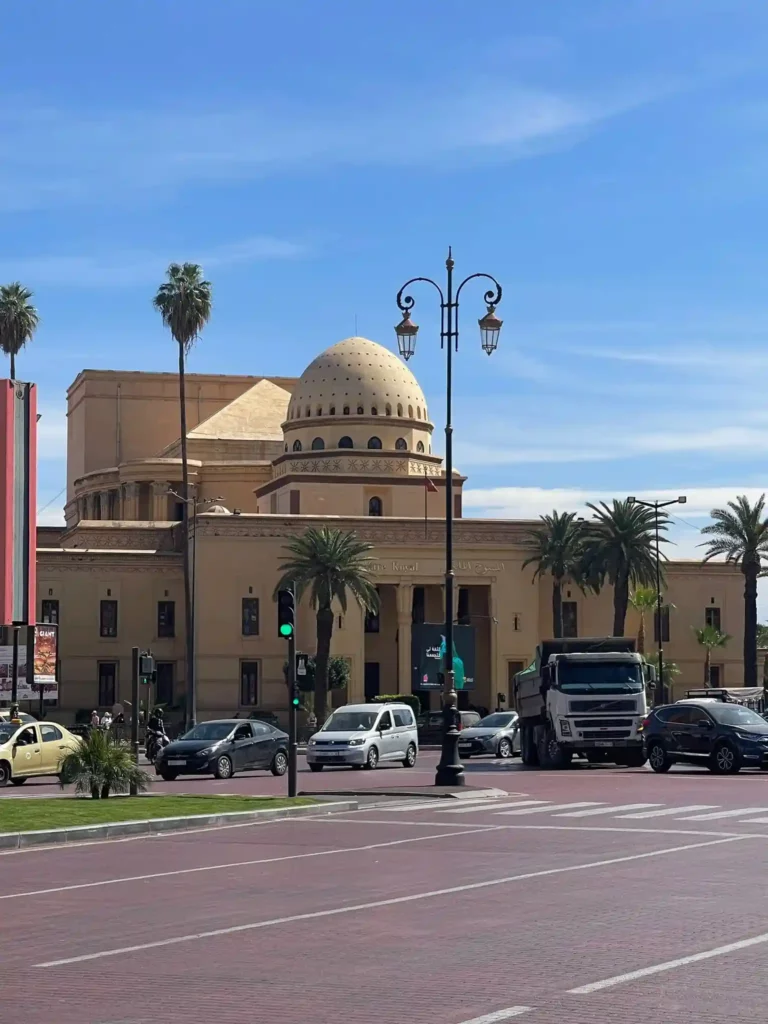
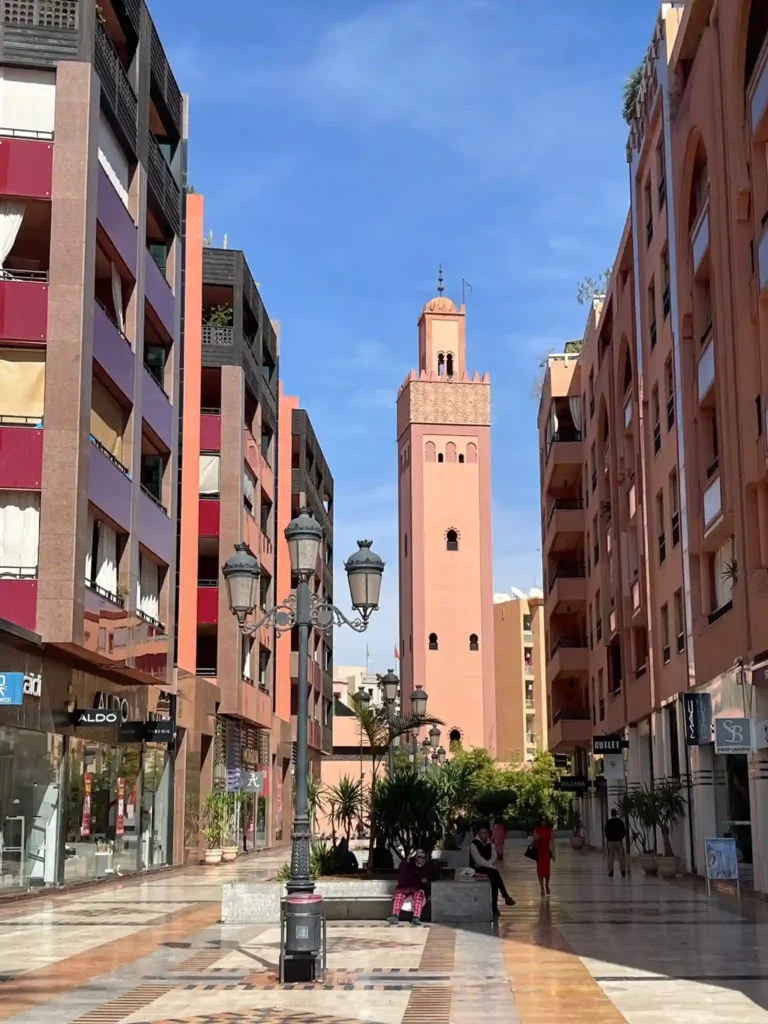
This part of town is buzzing with art, design, new business opportunities, and some really cool food spots that are getting noticed all over the world.
The heart of this modern vibe is in Gueliz, which isn’t exactly new since it was founded back in 1914. It used to be known as the French part of town, and people still call it the French quarter sometimes.
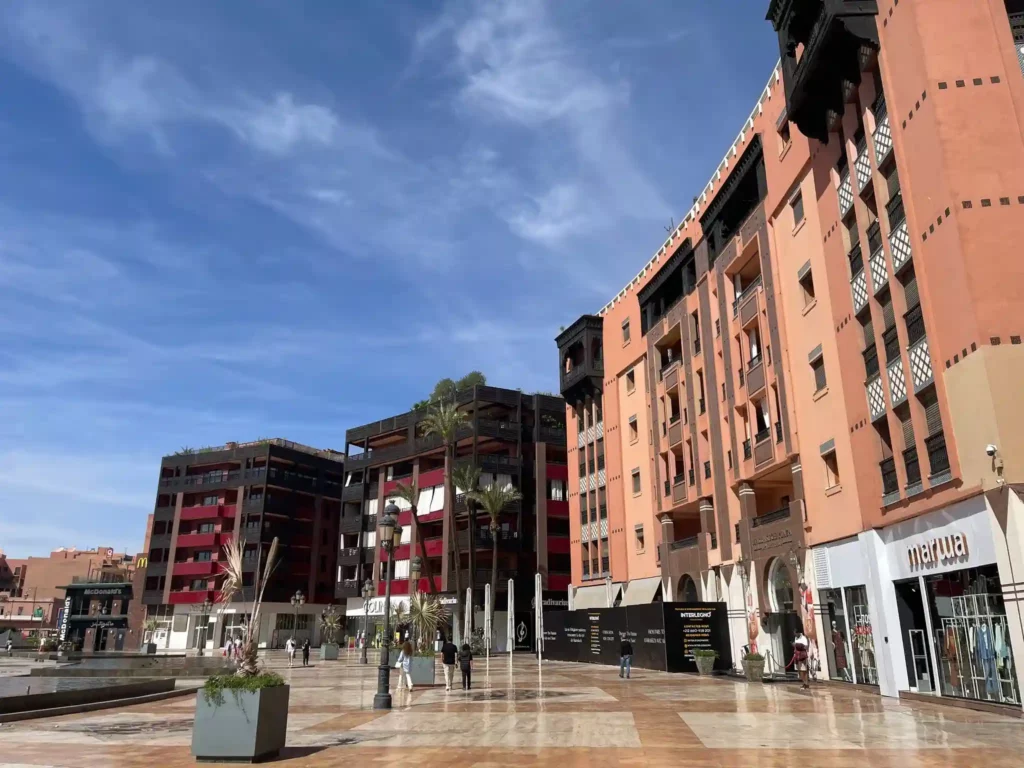
Walking around, you’ll see stores you recognize from home like Zara, H&M, and Starbucks. There’s also a bunch of new and unique shops and startups popping up, not just in Gueliz but all over, including the old Medina.
Best time to visit Marrakech
Marrakech, much like the rest of Morocco, swings between chilly winters and blistering summers.
Winter spans from December to February, and the warmth begins to creep in from March, lasting all the way until October.
However, the ideal times to visit Marrakech are during the dry, warm months, offering plenty of sunshine and fewer crowds.
March-May (Optimal visiting period): Springtime, from March to May, is arguably the perfect season to explore the Red City. During these months, the weather is comfortably warm, with temperatures fluctuating between 17°C and 37°C, making it ideal for sightseeing. Additionally, hotel rates tend to be more budget-friendly.
June-August (Peak season): The period from June to August marks the peak of summer in Marrakech. These months can be intensely hot and coincide with the peak tourist season in Morocco, resulting in long queues at major attractions and high accommodation prices.
September-November (Optimal visiting period): The months of September to November offer another great window for visiting Marrakech, as the heat begins to subside and the tourist crowds thin out, making it easier to enjoy all that the city has to offer.
December-February (Off-peak season): Despite the sunny days, winter in Marrakech can be surprisingly cold and somewhat damp, with temperatures ranging from 6°C to 20°C. This period sees fewer visitors, offering a different perspective on the city’s charm.
How to get to Marrakech?
Morocco has a reasonably well-developed transport system that includes a variety of options from planes and trains to taxis and buses. Depending on where you are traveling to Marrakech from, you can choose the best and most convenient transport to get to your destination.
There are two ways to get to Marrakech, by plane or by road. If you are coming from abroad, it means you will be flying but if you are traveling to Marrakech from other cities in Morocco, the most common way is by land. Keep in mind that you can fly also if you are coming from one of the Megacities like Casablanca.
By Plane
There is one airport in Marrakech, Marrakesh Menara Airport. It is located just 15 to 20 minutes frım the city center. With multiple national and international airlines linking the beautiful city of Marrakech to the outside world, the fastest, and sometimes, the only way to travel to Marrakech is by plane from Europe, the U.S, Canada, or Australia.
Traveling from the U.S: If you’re traveling from the United States, the only direct flight from the U.S. to Morocco is with Royal Air Maroc from New York JFC to Casablanca. The flight takes around seven hours. The connecting flight from Casablanca to Marrakech is only 50 minutes long.
Traveling from Canada: Since June 2016, Air Canada rouge offers non-stop flights from Montreal to Casablanca. From other Canadian cities, the cheapest alternatives are to fly to London, Madrid, or Paris and then get a direct flight to Marrakech (this can be with a low-cost carrier like Easyjet or Ryanair).
Traveling from Australia: There are no direct flights between Australia and Morocco. The biggest airlines that fly between the two countries with at least one connecting flight are:
Traveling from Europe: If you are flying from the United Kingdom, the most popular airline companies that fly to Marrakech are:
Other airlines that fly to Marrakech from other European cities are:
Note: If you live in Europe, and are scared of flying, you can drive down to Spain and cross to Tangier in Morocco by boat. But keep in mind that the drive is super long and exhausting.
Getting to Marrakech from other cities in Morocco
If you are already in Morocco and trying to get to Marrakech, Moroccan Airlines (Royal Air Maroc) arranges local flights from different cities in the country with a connection stop in Casablanca the main and biggest airport in the country. However, the easiest and hassle-free way to get to Marrakech from other cities in Morocco is by train, intercity bus such as CTM, grand taxi, and a rental car (driving yourself).
Where to exchange currency in Marrakech?
The currency used in Morocco is Dh (Moroccan Dirham) also referred to as MAD.
At the time of writing this post, one US Dollar ($1) costs 10.02 MAD, and it is quite stable as it does not fluctuate a lot.
Moroccan Dirham is a closed currency and it is normally unavailable outside Morocco. If you do find it in your home country, it will be at a much higher rate than in Morocco. So, better exchange your currency once you get to Morocco.
In Marrakech, like many places in the world, you can always find reputable and shady places to exchange your money so the best and safe way to do it is through authorized exchange offices (called Bureau de change in French) or banks.
I would recommend that you go with the exchange offices as they usually provide a slightly better rate than the banks.
There are several banks and bureau de change offices at Marrakech airport. If you don’t exchange your money at the airport for some reason, worry not! There are hundreds of banks and exchange offices in the city and you will not have to go far to find one.
Another way to obtain dirhams is through your Riad (Moroccan hotel) if you are staying in one. They sometimes exchange for their clients and at a good rate even.
If you don’t like bringing large sums of cash on trips, you can always withdraw Moroccan dirhams from an ATM. But keep in mind, the rate won’t be as good as bringing cash and exchanging it.
Travel Tip: Make sure to always bring new notes and good-quality ones that are not damaged.
Where to stay in Marrakech?
Best Neighborhoods to stay in Marrakech
#1 Old Medina // The Old Medina is certainly the first and best place to stay in Marrakech. Located in the heart of the city, this vibrant neighborhood is literally within walking distance of the most famous attractions in Marrakech including Jama El Fena, Koutoubia Mosque, Bahia Palace, and many more. The Old medina is also home to various Riads, hotels, souks, museums, and restaurants.
#2 Kasbah // Because the Kasbah neighborhood in Marrakech is very close to the Old Medina, it is my second recommended place to be close to the top attractions. However, accommodation and hotel options are very limited to one area in the Kasbah. Kasbah is where the Saadian tombs are and it is also possible to walk to other main attractions as well.
#3 Mellah // Mellah is the old Jewish district in the city. This area is great for history buffs. If you stay in Mellah you can visit the Jewish cemetery, the spice bazaars, and Heritage Museum. Plus, Jama El Fena is within just 20 minutes on foot.
Best Riads to say in Marrakech
The best places to stay in Marrakech are Riads. The word Riad means garden in Arabic. Mostly found in imperial cities, such as Marrakech, Fez, and Meknes, Riads are a type of traditional Moroccan house with Andalusi architecture with a beautiful garden centered around a fountain.
Riads were only owned by wealthy people in Morocco. Now, these mansions are for everyone. Most if not all of the Riads in Marakkech are now transformed into luxurious and traditional boutiques/ Guesthouses to accommodate tourists from around the world. People stay in Riads not to spend the night but for the luxurious experience, reminiscent of the good old days. These are the favorite Mid-Range Riads in Marrakech.
Riad Kniza
Located in Marrakech’s old Medina, the hotel retains the authentic old Moroccan layout, charm, and beauty reflected in all its rooms. Our experience in Riad Kniza was amazing and the food was really delicious.
Riad Maison Belbaraka
Maison Belbaraka is a charming little place situated just a few steps away from the famous Jama El Fena. It’s a great accommodation option to enjoy both an authentic Moroccan experience and the surrounding city treats.
Riad La Sultana Marrakech
La Sultana Marrakech is a luxury hotel with magnificent rooftop views. La Sultana Riad puts you just moments from the royal palaces, museums, and souks of the magical city of Marrakech.
What to Wear in Marrakech?
Depending on that time of the year, you will have to consider what to pack for your trip to Marrakech. In addition to the climate reason, respecting Morocco’s culture and traditions is an important factor that women carefully choose what to wear. Morocco is a Muslim country where people are religiously ordered to dress modestly for both men and women. However, for tourists, there is no specific dress code. You may want to dress more modestly so that people around you feel more comfortable and you don’t receive any unwanted attention from weird people.
While men can get away with shorts and t-shirts, women visiting Morocco are advised to cover their shoulders and legs. Wearing revealing clothes such as shorts, skirts, and dresses above the knee could result in unwelcomed looks and comments from locals, especially men.
How to get around in Marrakech?
You will be able to explore Marrakech on foot and sometimes the only way to get around is by walking. Once you land in the city, you will quickly notice the high number of bicycles and motorcycles in the city and they drive quite fast so be careful.
Most attractions you want to see are centered around the Medina neighborhood. So, if you stay around Medina, you will enjoy short walks to get to your destination. However, navigating the narrow streets in the old Medina can be tricky and confusing, especially because most maps feature names and addresses that don’t always correspond to the layout on the ground.
To get around Marrakech easily, you will have to rely on asking for directions (Check our Moroccan Arabic post to learn a few Moroccan Darija sentences). In addition to the crazy motorcycles in the city, there are multiple public transport options to consider for longer trips such as Taxis, buses, and the popular horse-drawn carriages.
Public buses are to be avoided. They are usually fully packed and not really safe to take. The taxis are a good alternative. There are two types of Taxis in Marrakech, white big ones called “Grand Taxi” and yellow small ones called “Petit Taxi“. Grand Taxi is for far-away destinations and day trips outside the city, and the Petit Taxi is the one you will be using around the city center.
When you take a Small Taxi, make sure to ask the driver if he uses the taximeter, if not he does not, look for another taxi or negotiate the price of the trip before you jump in. To get around Marrakech Medina, the price is usually between 15MAD to 25MAD ($1.67-$2.79)
Although horse-drawn carriages are more like a tourist experience than reliable transport to navigate the city, you should not miss out on the experience. You can enjoy a 30-minute city tour on a four-wheeled buggy ride. Like everything in Marrakech, the ride’s price is negotiable but it should generally cost you between 200MAD-250MAD ($22.33-$27.91)
What to eat in Marrakech?
Marrakech is the best place to try authentic Moroccan food. Moroccan cuisine is rich in surprisingly delicate flavors and culture. With the unlimited food options that the country has to offer, I’ve written a detailed Moroccan food guide that lists more than 30 different dish samples. If you are new to Moroccan cuisine and not sure what to eat in Marrakech, check it out.
Important Marrakech travel tips
Plan ahead
Some people are spontaneous when it comes to traveling, I like planning! It is not bad to be adventurous and spontaneous with your traveling decisions, but if it’s your first time in Morocco or Marrakech, I believe you should be a little bit prepared.
Your first step toward planning for your trip to Marrakech is you reading this post which is good. Planning your itinerary activities and things you want to do or see in the city will give you freedom and time to explore more.
Worrying about where to go and what to see while in Marrakech is a huge waste of time. I’ve been there so trust me you don’t want to experience it. So, plan ahead!
Read more: How To Spend The Best 3 Days In Marrakech?
Pack for the weather
Make sure to check the weather in Marrakech before you start packing your bags. Marrakech is super hot in supper and extremely cold in winter. You want to make sure you pack the right closes for your trip. If you have n idea what to wear for your trip check our Morocco Packing Guide for an idea.
Buy travel insurance
Although it’s not always needed, I feel more comfortable buying travel insurance when on the move. Our favorite one is from World Nomads, a trusted insurance company used by most travelers and nomads.
You can choose not to buy one for your Marrakech trip. However, if you are planning on some physical activity like mountain climbing or horse riding, I highly advise you get a quote from Word Nomads or any other company you prefer.
Bring a power adapter
Morocco uses power outlets and plugs of types C & E. If you are not sure what these plugs look like, check this plug guide website. Also, the standard electrical voltage in Morocco is 127V with a standard frequency of 50Hz.
Buy a sim card and internet
Unfortunately, WIFI is not available everywhere you go in Marrakech. So, unless you have international internet credit on your mobile, buying a SIM card and internet is so important.
You can pick it up easily from the airport. There are three mobile networks in Morocco: Maro Telecom, Orange, and Inwi. All of them provide a good internet connection and cheap packages.
A SIM card and a 10GB internet package will cost you around $17.
Always bargain
Once you land in Morocco, you will soon notice that bargaining is something very common and welcomed, especially among locals. Also, being a tourist in Morocco often means you will be overcharged. That’s why you should not be shy to haggle with shop owners and taxi drivers.

Morocco is highly on my travel wish list and now even more so! I’ll be saving this for when I get to go! Thanks for all the information!
I am glad you mentioned taking a cooking class. It’s not something I would have thought of doing, but would LOVE to do.
I’ve been really toying with the idea of heading to Morocco on a solo trip, was just wondering if you recommend it?
Hello Shafinah, a solo trip to Morocco is not for everyone but if you are into adventure trips yes I would highly recommend it. Safety-wise, there is nothing to be afraid of in Morocco as long as you follow the guidelines and tips we shared. We have a post about what you should do and not do in Morocco plus many other helpful guides. Make sure to check them out! Happy travels
Marrakech has always been on my list. This has just reiterated why. Thank you
Morocco is very high on my bucket list and this post is perfect for my future travel plans! I love that you included all of the details down to the airlines you can fly to get there. I also loved the tip about tipping someone who helps you if you get lost. Those types of tips are critically important for a safe trip. Amazing post!